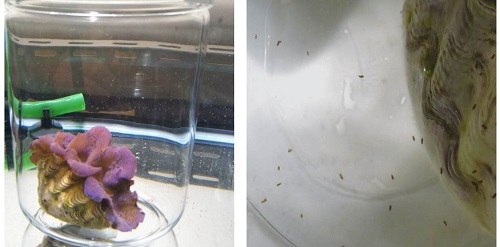Professor, Graduate School of Integrated Sciences for Life, Hiroshima University
E-mail: kazkoike*hiroshima-u.ac.jp (Please change * into @)
--Viable zooxanthellae1) are contained in fecal pellets of adult giant clams2)
--Juveniles of a giant clam (Tridacna squamosa) took up the fecal pellets and establish symbiosis with zooxanthellae
--This finding first demonstrated that one of the symbiont sources3) in coral reefs is the fecal pellets from adult giant clams
Similarly to corals, giant clams possess symbiotic algae (zooxanthella) in their body and receive photosynthetic products that needed for their growth. The zooxanthellae are not maternally inherited but must be taken up from the environment, however; there have been few reports proofing zooxanthellal population in the coral reef environment.
Dr. Kazuhiko Koike, professor of the Graduate School of Integrated Sciences for Life, Mr. Shin-ya Morishima, a graduate student of the school and other research team members found viable zooxanthellae were expelled in fecal pellets from one of the giant clam species (Tridacna crocea) and found that the zooxanthellae in the fecal pellets could be re-infected to giant clam’s larvae.
This finding has been published on-line in PLOS ONE.
1) Zooxanthella(e): symbiotic microalgae living in corals, giant clams, jellyfishes, etc, those inhabiting shallow coral reefs
2) Giant clams: Large bivalve shellfishes inhabiting tropical coral reefs. Some of the species are overfished and categorized in IUCN Red List.
3) Symbiont source; Many of zooxanthella-bearing animals take up zooxanthella from the surrounding water, therefore free-zooxanthella (symbiont source) must be in the environment, which has not been clarified as yet.

E-mail: kazkoike*hiroshima-u.ac.jp (Please change * into @)
Date : 2019/07/25
Copyright © 2003- Hiroshima University